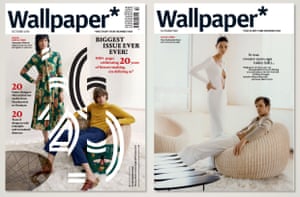Luxury Magazines Defy Print Market Gloom
Mark Sweney @marksweney

With 100-year-old Vogue and design and lifestyle bible Wallpaper producing their biggest-ever issues – and “handbag” size pioneer Glamour seeking to bulk up to a bigger, glossier edition – the luxury magazines appear to be defying the advertiser and reader exodus rapidly eroding the rest of the magazine market.
More than a million British consumers stopped buying print magazines, or gave up their subscription, in the year to the end of June. Titles such as Loaded, Zoo, Nuts, FHM, Company, InStyle and Reveal have closed or embarked on digital-only reimaginings, while the 64-year-old music bible NME has been forced to go free to find an audience as paying print fans dry up.
This is in contrast to the fortunes of the luxury magazine market, which appears resilient to the wider change in consumer reading habits in the digital age. Nicholas Coleridge, international president of Vogue to Tatler owner Condé Nast, said that content on a tablet or iPad cannot match the experience of that “magazine moment”.
“It is very hard to replicate the physical allure of a luxury magazine on other platforms,” he sid. “[It is] something to do with the sheen of the paper, the way that the ink sits on the page, the smell of money and desire that wafts off the page. Readers move into a different mode when they engage with a glossy. Advertisers understand this.”
While WPP’s Group M media arm has forecast print ad spend on consumer magazines in total will fall 14% this year, to £320m, the luxury market is breaking records.

Vogue’s centenary issue in June, which featured the Duchess of Cambridge on the cover, was at 464 pages its biggest ever – and contained a record number of pages of advertising (264). Time UK’s Wallpaper – in its 20th year – put out a record 508-page edition in September with a bumper 230 pages of advertising.
“Many people say that press advertising is dead or dying, but glossy magazines are holding their own,” said Jo Blake, head of publishing at Havas Media Group. “For many luxury [advertising] clients it is first and foremost the prime medium, more so than TV, because they know competitors will all be in there. [High-end] magazines are still number one for those advertisers.”
Earlier this year Coleridge, whose goddaughter Cara Delevingne’s appearance on September’s Vogue helped drive sales to 230,000, pointed out that a number of its luxury titles are doing better than in the pre-internet days. Vogue sold 135,000 copies in 1989 but now sells about 200,000 on average; Tatler has grown from 25,000 to approximately 90,000 and GQ is up from 40,000 to over 100,000. Condé Nast’s latest trend-bucking move is to ditch the famous “handbag” size that revolutionised the market when Glamour launched 15 years ago.
In a seemingly costly, and counterintuitive, move the magazine is to get bigger, to the size of Wired, even though paper costs are expected to rise because of the weakness in the pound since the Brexit vote..
Publishing director Jamie Jouning says that the move is fuelled by a demand from premium advertisers, who felt that the smaller size “has not always done full justice to their creative”.
Rival Hearst UK – publisher of Harper’s Bazaar, Esquire, Elle and Good Housekeeping – has started to take a different approach with some of its titles. Elle is being given away in beauty boxes, while Harper’s Bazaar has been offered at events such as the Blenheim Palace horse trials. Such moves have helped boost total circulation figures and pushed the brand to new consumers.
Even so, there is a sense that the digital revolution is looming.

Hopes were initially high for digital tablet versions of magazines following the launch of Apple’s iPad in 2010. However, that has given way to a more sober assessment: while digital edition circulation is up 50% year-on-year, to 585,000, most of this is driven by brands in the news and current affairs sectors, such as the Economist, The Week and Spectator.
Group M estimates that if this sector of magazineswas stripped out, digital circulation actually fell by as much as 10% across all other titles it samples in the first half of the year.
“We don’t think digital editions of magazines have worked at all, bar one or two exceptions,” said Douglas McCabe, chief executive at Enders Analysis. “While these premium brands will continue to play an important role with advertisers and readers, there are risks from [social and digital] media from the rise of bloggers and vloggers.
“Digital has brought down the barriers of entry for [creating and showcasing] content, recommendation and discovery of products. Magazines will have to fight hard to compete with that going forward.”




